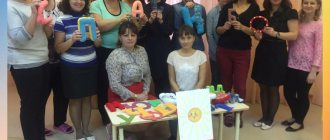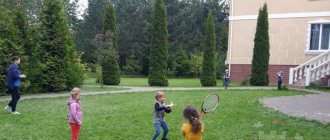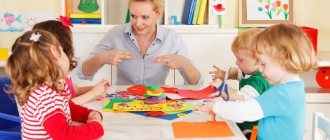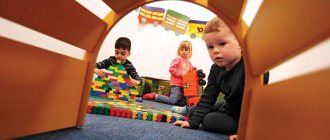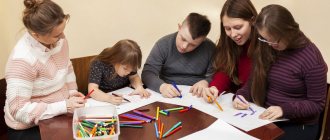Workshop for teachers “Organization of story-based games in kindergarten”
• reporting any new fact during the game.
Teacher-observer,
if necessary
(senior preschool age
) assistant.
The task is to develop the skills to build a plot together, understand your partner in the game, and coordinate your actions with other participants in the game:
• advice (for example, remind that the main role can be performed alternately);
• an appropriate question before the start of the game;
• assistance in combining several plots into one comprehensive game (with hints, hints, advice, questions, suggestions, not at all intrusive)
• direct intervention in the game if it has acquired a negative direction (the teacher, in a playful way, pushes for ways out of the current situation).
Creation of a developing subject-game environment
In order for children’s play activity to develop successfully, it is first necessary to take care of its saturation. All types of toys in a group should be selected taking into account the age, interests of children and the goals of their development, education, and training.
Teachers of early and junior preschool age groups must constantly replenish and change situations in play areas. There should be a large variety of toys and in several copies. At this age, toys are the starting point of organizing role-playing games.
In groups for children of senior preschool age, it is no longer toys that determine the content of the game, but, on the contrary, the content of the game determines the choice of toys. Older preschoolers are able to adapt various substitute objects for play, while showing extraordinary ingenuity. Therefore, in groups for children of senior preschool age there should not be a large number of toys; their excess muffles the interest of children and limits the possibilities of creative imagination.
The teacher can help children understand that some substitute objects can easily be turned into any attribute needed for the game during the game. Let's say, colored paper - it's easy to tear it into small pieces (salad, roll it into a tube (thermometer, draw a pattern on it (tablecloth, napkin, rug). Each such thing is valuable because it is made by the child himself. Therefore, it would be appropriate in every group have, for example, a box with waste material, and in it various boxes, scraps of fabric, sticks, ribbons, bows, pieces of fur and other material that may be required in the game. It is important that the substitute object resembles the depicted object in general contours or in some way then a typical property, a characteristic detail.
If younger preschoolers usually get acquainted with these objects with the help of a teacher who shows ways to play with them and sequential actions, then children already independently use the conditional play environment to develop the plot, while defining their roles. Using substitute objects, children go beyond traditional games and increasingly reflect the phenomena of the surrounding reality.
Seminar-workshop “Play with children!”
| Seminar-workshop for parents “Play with your children!” |
Goal: To increase the pedagogical competence of parents on the problem of gaming activities in children of middle preschool age, to give parents knowledge about the importance of games in the development of a child, about the influence of games on the development of communicative abilities in children;
Tasks:
- To form parents’ concept of the possibility of play as a means for the development of intellectual and cognitive activity.
- To give parents knowledge about the importance of play in the development of a child, about the influence of play on the development of communication abilities in children
- Stimulate parents' interest in joint play activities with their own child.
- Discuss the issue of organizing a play environment in kindergarten and family settings; about the advantages and disadvantages of toys.
Progress of the event:
The song “Where does childhood go” is playing.
The teacher's opening speech, he opens the parent meeting, announces the agenda, and introduces the procedure for holding it.
1. Theoretical part.
Consultation for parents “Game is a child’s leading activity”
Hello, dear parents! I'm very glad to see you! And I want to start our meeting with the words of V. Sukhomlinsky:
The years of childhood are, first of all, the education of the heart. Education is not the sum of events and techniques, but the wise communication of an adult with the living soul of a child.
Today we will talk to you about children's games, toys, their significance in understanding the world around us, and their impact on the development of our children. Many of us still remember our favorite toys and games. They preserved memories of our childhood games and fun; we “return” many years ago, to our childhood. In many families, toys are passed down from generation to generation; these toys have a certain value - pleasant, good childhood memories.
— In order for our conversation to be sincere and frank, I suggest you fill out a business card. On a business card, write your name, patronymic and draw a picture that matches your mood (sun, cloud, etc.)
Psychological warm-up “Smile”
— I want to know: are you in a good mood? How to give it to other people without words when they meet? How to communicate your good mood without words? Of course, with a smile. Smiled at the neighbor on the right, smiled at the neighbor on the left. A smile can warm you with its warmth, show your friendliness and improve your mood.
Ball game.
Please answer questions honestly and frankly.
- What game did you play with your child recently?
- If a child asks to play with him, your actions.
- What games does your child play most often?
- When choosing a new toy, what do you take into account, what are you guided by?
- Do you tell your child what games you played in childhood?
- If a toy breaks, what do you do in such cases?
- Where does your child play at home? What conditions have been created?
- What are your child's favorite toys?
- Who plays with the child more often: mom or dad?
This topic, “The Role of Play in the Development of Preschool Children,” was not chosen by chance, because each of you dreams that your child will grow up smart, independent, and that in the future he will be able to take a worthy place in the life of society. Children are brought up in games as well as in other activities. By performing one or another play role, they seem to be preparing themselves for the future, for the serious life of adults. We can say that the game is a time machine for a child: it gives him the opportunity to live the life that he will have in many years. The importance of play and its influence on the development of a child’s personality cannot be overestimated. Like a magic wand, play can change children's attitude towards everything. The game can unite the children's team, involve introverted and shy children into active activities, and instill conscious discipline in the game.
Play is the leading activity of a preschool child and the best way to resolve issues in the upbringing and development of a child.
Games are very diverse and can be divided into two large groups: role-playing games and games with rules.
Role-playing games are a source of formation of the child’s social consciousness and the possibility of developing communication skills. These are games such as “Shop”, “Guests”, etc.
Role-playing games are games in which children imitate the everyday, work and social activities of adults, for example, games kindergarten, hospital, daughters and mothers, shop, railway. Story-based games, in addition to their cognitive purpose, develop children's initiative, creativity, and observation.
The life of adults interests children not only for its external side. They are attracted to the inner world of people, the relationships between them, the relationship of parents with each other, with friends, with other people. Their attitude to work and to surrounding objects. Children imitate adults: their manner of communicating with others, their actions. And they transfer all this into games, thus consolidating the accumulated experience of behavior and forms of relationships.
The game effectively develops the ability to live and act together, to help each other, and develops a sense of collectivism and responsibility for one’s actions.
However, without the guidance of an adult, even older preschoolers do not always know how to play. In kindergarten, we teachers play with children. And at home, one of the older family members can get involved in the game and become a link between the children, teaching them to play together. Joint games between parents and children enrich children spiritually and emotionally, satisfy the need to communicate with loved ones, and strengthen self-confidence. This group includes theatrical games that children really like, and they take an active part in them with great pleasure.
Theatrical play is an effective means of communicative development and creates favorable conditions for developing a sense of partnership and mastering ways of positive relationships.
. Theatrical toys - bi-babo dolls, finger theater, table theater.
— Do children need these toys? (parents' answers)
— These toys develop speech, imagination, and teach the child to take on a role.
In play, a child acquires new knowledge and refines existing knowledge, activates his vocabulary, develops curiosity, inquisitiveness, as well as moral qualities: will, courage, endurance, and the ability to yield. The beginnings of collectivism are formed in him. In play, a child depicts what he has seen and experienced; he masters the experience of human activity. The game develops an attitude towards people and life; a positive attitude in games helps to maintain a cheerful mood.
Adults, playing with children, enjoy themselves and bring great joy to the children. Dear parents, make flat figures with the whole family from cardboard and other materials; this will give children the opportunity to independently act out familiar works of fiction and invent fairy tales.
Musical toys - rattles, bells, bells, pipes, metallophones, toys representing a piano, balalaikas and other musical instruments.
— What can musical toys develop in a child? Musical toys promote the development of speech breathing and hearing.
The second group of games are games with rules. These include: didactic, board, and outdoor games.
Didactic games - specially developed for children, for example, lotto to enrich knowledge and develop observation, memory, attention, and logical thinking.
Outdoor games are varied in design, rules, and the nature of the movements performed. They help improve children's health and develop movement. Children love active games, listen to music with pleasure and know how to move rhythmically to it.
Construction games - with sand, cubes, special building materials, develop children's constructive abilities, serve as a kind of preparation for mastering later labor skills;
Games: lotto, dominoes, paired pictures, etc. provide children with the opportunity to enjoy the game, develop memory, attention, observation, and eye. Despite the fact that games are educational, group play also teaches communication.
Such games have an organizing effect because they require strict adherence to the rules. It is interesting to play such games with the whole family, so that all partners are equal in the rules of the game.
The participation of adults in children's games can vary. If a child has just been bought a toy and he knows how to play with it, it is better to give him the opportunity to act independently. But soon the child’s experience is exhausted. The toy becomes uninteresting. Here we need the help of elders, to suggest a new game action, to show them, to offer additional game material for the existing game (you always need to have a piece of fur, fabric, cardboard, wire, box, etc. on hand).
When playing with your child, please watch your tone. The even, calm, friendly tone of an equal playing partner gives the child confidence that they understand him and want to play with him.
The child is very happy about the minutes given to him by his parents in the game. Communication in play is never fruitless for a child. The more precious moments he has in the company of people close to him, the more mutual understanding, common interests, and love there will be between them in the future.
- Practical part.
1. Game-task
Dear parents, I offer you an unusual task: remember your family evenings and give them self-esteem. If you do as told, then you place a red chip, not always yellow, never blue.
- Every evening I spend time playing with the children.
- I talk about my games as a child
- If a toy is broken, I repair it together with the child. Having bought the child a toy, I explain how to play with it, and show different options for the game.
- I don’t punish a child with games, toys, etc. I don’t deprive him of games or toys for a while
— If there are more red chips on your table, then the game is always present in your house. You play as equals with your child. After all, play is the most interesting thing in a child’s life.
- Stories from parents from the experience of family education “Games in the family.”
- Game "Logic Train".
Educator: You can’t get to a magical land by regular transport. Let's create an unusual train. (We approach the easel), look, there is a train, but no carriages. The cars will be pictures, they need to be laid out so that each picture is somewhat similar to the next picture: the images in the picture can be the same color, can have the same shape, or can perform the same action. Or maybe something else unites them, even something that is not visible in the picture, but this happens in life. (Pictures - trailers are connected to each other using a logical connection.)
The first trailer I will attach is a picture of a Christmas tree, because the train and the Christmas tree are green. What do you think is the next picture of a trailer that should be attached? (I attach a pine cone because fir cones grow on spruce trees. A squirrel because a squirrel gnaws cones. A cat because it also knows how to climb trees, like a squirrel. A chicken because it lives at home, next to a person, like a cat . The sun, because it is yellow like a chicken. A fur coat - it warms like the sun, mittens are also clothes, etc.)
4. Exercise “I’ll start, and you will continue” - “The game is...”
A game is (fun, interesting, exciting...).
To make the game interesting, educational, etc.
should any toy be ? (parents' answers)
- aesthetic;
- safe (in terms of paint, material quality);
- develop;
- entertain the child.
- Games in the kitchen
- Now we’ll play a little more. I ask everyone to take part. We have prepared questions for you. (There are pieces of paper with questions in the vase.)
— The whole family spends a lot of time in the kitchen, especially women. Do you think it’s possible for a child to find something to do there? What can a child do using the following materials? (parents pull notes from the vase)
(Music sounds, the vase moves in a circle. The music stops, the one in whose hands the vase is answers. Those who wish can complete the answer.)
- "Egg Shell"
Crush the shell into pieces that a child can easily pick up with their fingers. Apply a thin layer of plasticine to the cardboard - this is the background, and then invite the child to lay out a pattern or design from the shell.
- "Dough"
Sculpt whatever you want.
- "Pasta"
Lay out fancy patterns on a table or sheet of paper, studying shapes and colors along the way.
- "Semolina and beans"
Mix a certain amount, offer to choose beans from semolina.
- "Peas"
Transfer the peas from one cup to another. Sort: peas, beans
- "Hercules»
Pour the cereal into a bowl and bury small toys in it. Let him find it.
- "Various small grains"
Invite the child to draw pictures with grains. For very small children, use a spoon to pour the cereal from a bowl into a bowl.
- "Disposable cups"
You can insert one into the other, make pyramids of different heights.
- “Breakfast cereal rings”
Offer to lay out drawings from them or string them on strings - beads and bracelets.
6. Creative work of parents
“We are now convinced that you can play with your child in the kitchen too.” I suggest you make your own artistic applique from plasticine and various cereals, so that you can do this at home with your kids. Go to the table and take all the materials you need for work (parents perform appliqué while listening to music).
- Be sure to show your work to the kids at home and make it even better with them!
3. Final part.
— The meeting is coming to an end. I would like to express my gratitude to you for your participation and for taking the time to come to our round table meeting. I think that now each of you will be able to answer the question from our meeting: “The role of play in a child’s life.”
Reflection:
- Impressions from the parents' meeting.
- What conclusions did you draw (statements from parents).
Childhood is not only the happiest and most carefree time of a person’s life. The poverty and primitiveness of the game have a detrimental effect on the development of personality, as well as on the communicative development of children - after all, communication occurs mainly in joint play. Playing together is the main content of communication. By playing and performing various game roles, children learn to see events from different positions, take into account the actions and interests of others, and observe norms and rules. Play is the leading activity in preschool age, an activity that determines the development of the child’s intellectual, physical and moral strength. The game is not empty fun. It is necessary for the happiness of children, for their health and proper development. The game pleases children, makes them cheerful and cheerful. While playing, children move a lot: run, jump, make buildings. Thanks to this, children grow strong, strong, agile and healthy. The game develops children's intelligence and imagination. By playing together, children learn to live together, give in to each other, and take care of their comrades.
And in conclusion, I want to tell you: Let's play with our children as often as possible. Remember, play is an excellent source of strengthening a child’s physical, spiritual and emotional well-being. Discover the world with your child! See you again!
